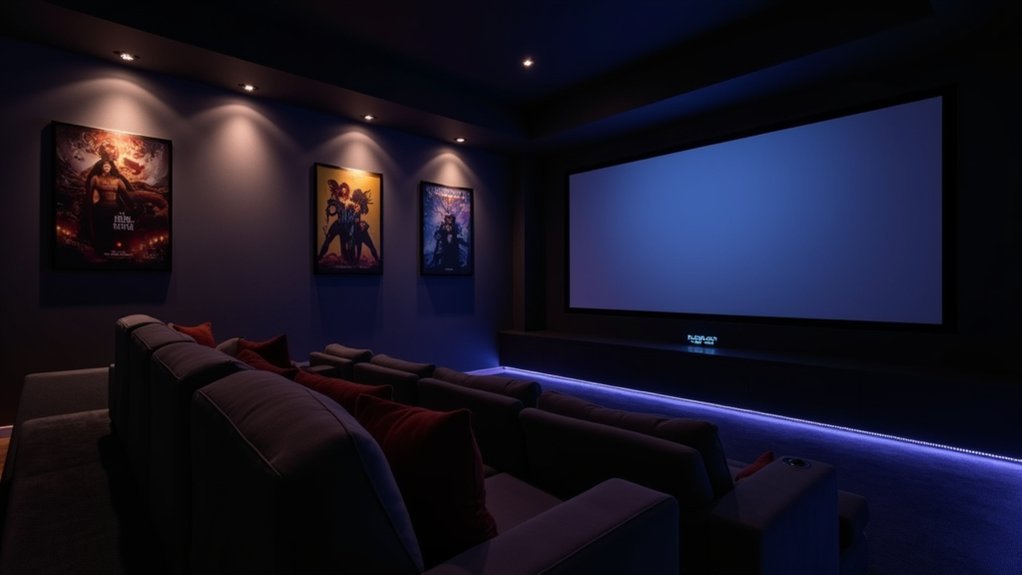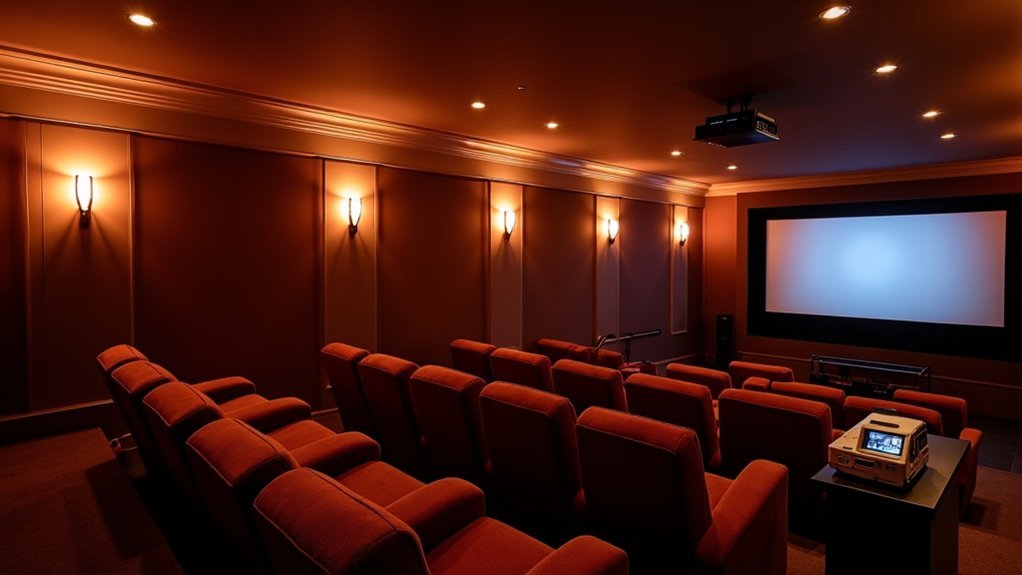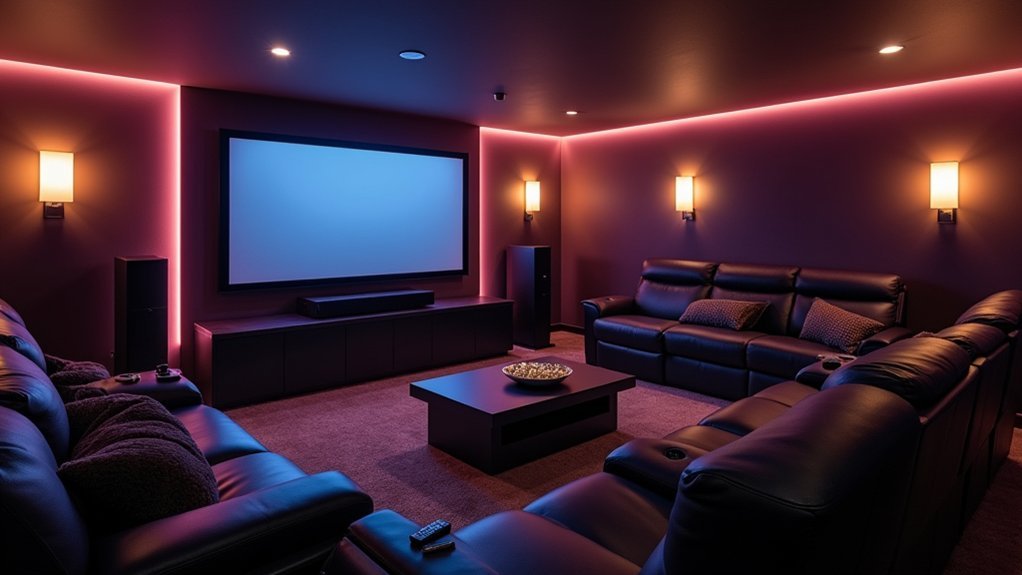To connect lighting to your home theater, choose dimmable, warm-toned LED bulbs (2700K-3000K) with high CRI ratings. Install fixtures in key zones: seating area, screen surroundings, and pathways. Connect your lights to smart controllers compatible with your AV system through Wi-Fi, Zigbee, or Z-Wave protocols. Program scene presets like “Movie Time” or “Intermission” for one-touch atmosphere changes. The right lighting setup will dramatically enhance your viewing experience beyond what you’ve imagined.
Understanding Home Theater Lighting Requirements

While most home theater enthusiasts focus primarily on audio and video equipment, proper lighting can dramatically transform your viewing experience from good to exceptional.
You’ll need to take into account several lighting types to create the perfect atmosphere: recessed lighting for unobtrusive illumination, wall sconces for indirect glow, task lighting for safe movement, and ambient lighting for overall mood.
When selecting fixtures, prioritize warm color temperatures (2700K-3000K) and high CRI (90+) for accurate color reproduction. Creating at least two distinct lighting scenes for setup/cleanup and movie viewing will optimize both functionality and experience.
All lights should be dimmable to adjust brightness levels for different activities. Position recessed lights 3-4 feet apart, install sconces at armrest height, and make sure all task lighting doesn’t create screen glare.
Remember that proper lighting isn’t just about aesthetics—it enhances safety, reduces eye strain, and completes your theater experience.
Planning Your Smart Lighting Ecosystem
When planning your smart lighting ecosystem for home theater, you’ll need to select control systems that work seamlessly with your existing entertainment setup.
Create distinct lighting zones that enhance the viewing experience, such as accent lighting behind the screen and ambient lighting for pathways.
You can achieve impressive results even on a limited budget by prioritizing key areas and choosing cost-effective solutions like LED strips rather than investing in premium smart bulbs throughout. Consider whether your setup would benefit from a hub-based system that prevents Wi-Fi overcrowding when connecting multiple smart lights.
Selecting Compatible Control Systems
How do you guarantee your home theater lighting works seamlessly with your existing setup?
Start by identifying which wireless protocol your current devices use—Wi-Fi, Zigbee, or Z-Wave. This determines compatibility with control systems like Control4, Savant, and Crestron.
For DIY setups, choose hub-based systems like Philips Hue or hubless Wi-Fi options like Cync.
Check if your existing wiring meets requirements (such as neutral wire needs). The emerging Matter standard allows mixing brands while maintaining unified control.
Stick with products from the same ecosystem for the most reliable performance.
Consider your preferred control method—wall switches, voice commands, or mobile apps. Look for systems that offer multiple interaction options to ensure everyone in your household can easily manage the lighting.
Professional installation may be necessary for premium systems, while DIY options offer user-friendly setup for basic configurations.
The right system enables scene presets that transform your viewing experience with one touch.
Defining Lighting Zones
Creating distinct lighting zones forms the foundation of any effective home theater lighting system. For ideal results, divide your space into 3-5 primary areas: seating, screen, pathways, perimeter, and equipment zones.
Your seating area requires comfortable task lighting that won’t interfere with viewing, while the screen zone needs indirect illumination to prevent glare. Consider installing bias lighting behind your screen to reduce eye strain during extended viewing sessions. Install pathway lights along walking routes to guarantee safety without distracting from the movie experience.
Place each type of lighting—overhead, sconces, and floor—on separate circuits for independent control. This approach enables you to create customized scenes for different activities, from movie watching to social gatherings.
When planning your zones, maintain appropriate spacing between rows and make sure light fixtures don’t shine directly on your screen. This zoned approach improves energy efficiency while maximizing viewing comfort.
Budget-Friendly Integration Options
While establishing your lighting zones provides the framework for your home theater lighting, you don’t need to break the bank to implement smart control. Entry-level options like Govee Wi-Fi LED Bulbs offer impressive features at just $14 per bulb or $24 for a two-pack.
Look for bulbs with direct Wi-Fi connectivity to eliminate the need for additional hubs. IKEA’s smart lighting solutions provide excellent value, with starter kits that include gateways for centralized control.
For maximum savings, purchase multi-packs and opt for long-lasting LED bulbs. Most budget-friendly smart bulbs work with Alexa and Google Assistant, enabling voice control and basic automation. Smart lighting represents an affordable entry point into broader smart home technology that you can expand over time.
You can create movie-centric lighting scenes, schedule dimming for film starts, and control your lighting environment without investing in premium systems.
Selecting Compatible Lighting Fixtures and Controllers
When selecting fixtures for your home theater, you’ll need DMX controllers to manage sophisticated lighting effects and scene shifts with precision.
These controllers offer advanced programming capabilities beyond basic dimmers, allowing you to create dynamic lighting sequences that enhance your viewing experience.
Always confirm your controller’s load capacity matches your fixture requirements to prevent system failures and guarantee smooth operation of your entire lighting setup.
For stylish illumination options, consider modern wall sconces ranging from wall-mounted fixtures like the Contemporary Full Cylinder or Three Tiered Ziggurat that complement your theater’s aesthetic while providing ambient lighting.
Choose DMX Controllers
Selecting the right DMX controller forms the foundation of your home theater lighting system.
You’ll need to calculate how many channels you require by multiplying each fixture’s parameters by the number of fixtures in your setup. For most home theaters, controllers supporting 24-256 channels are sufficient.
Look for controllers that offer both manual control and programmable scenes to maximize flexibility. These controllers can transmit messages to trigger specific lighting effects throughout your home theater space.
Many modern options include wireless DMX capability, eliminating complicated cable runs while maintaining reliable operation.
Consider whether you’ll need integration with your existing smart home system—many controllers now support protocols beyond DMX512 to work with Philips Hue or other consumer lighting.
Finally, check power requirements, as some controllers need external power supplies while others draw power from connected dimmers.
Consider Load Requirements
Once you’ve selected your DMX controllers, understanding your system’s load requirements becomes the next critical step in your home theater lighting design. Calculate the total wattage of all fixtures and verify it doesn’t exceed your circuit capacity, typically 15-20 amps at 120V in residential systems. Consider installing oversized neutrals for any circuits powering dimmers due to the significant harmonics they produce.
| Circuit Type | Max Load (120V) | Recommended Usage |
|---|---|---|
| 15-amp | 1,800 watts | Small theater setups |
| 20-amp | 2,400 watts | Medium installations |
| Dedicated | 3,600+ watts | Professional systems |
Distribute your lighting across multiple circuits to prevent overloads, and select controllers rated for your total wattage. Always maintain a 20% buffer below maximum capacity to handle inrush currents. For safety, follow NEC requirements and consider professional assessment if your calculations approach circuit limits.
Wiring Considerations for Theater Room Lighting

Proper electrical wiring serves as the foundation for any successful home theater lighting system.
You’ll want to install separate circuits for your lighting and AV equipment to prevent electrical interference that causes humming or noise issues.
Choose appropriate wire gauge based on distance – thicker 12 or 14 gauge for runs exceeding 50 feet, while 16 or 18 gauge works for shorter distances. This prevents voltage drop that can affect performance.
Plan your layout carefully, including dimmer placement and lighting zones.
Verify your dimmers are compatible with your chosen fixtures, especially if using LEDs, to avoid flickering.
For safety and peak performance, follow NEC guidelines and consider consulting an electrician.
Proper labeling of circuits will make future maintenance much easier.
Installing lighting on different legs than your AV equipment can introduce unwanted electrical noise and video interference in your home theater system.
Programming Scene-Based Lighting Presets
With your wiring infrastructure in place, you can now focus on the creative aspect of your home theater lighting: programming scene-based presets.
These customizable settings let you create and recall specific lighting ambiances with a single button press. Start by defining essential scenes like “Movie Time,” which dims main lights while maintaining subtle pathway illumination, and “Party Mode” for social gatherings.
For each preset, adjust intensity levels, color cues, and fixture focus to match the intended mood. Each preset should include parameters for specific parameters like intensity, color, and focus. Organize your presets logically by function or location for quick access.
Consider programming automated shifts between scenes—like gradually dimming lights when your movie begins. You can also link presets to schedules or motion sensors for hands-free operation, ensuring your lighting seamlessly enhances every theater experience.
Integrating Lighting With Your AV Control System

The most significant upgrade to your home theater experience comes from integrating your lighting system with your audiovisual control setup. AV integrators can seamlessly connect your lighting control, shading, and home automation systems into one unified interface. Synchronized experiences in home theaters become possible when lighting and AV components work together harmoniously.
| Control System | Integration Benefits | User Experience |
|---|---|---|
| Control4 | Central management of all devices | One-touch scene activation |
| Universal Remote | Compatible with IR dimmers | Simplified operation |
| Voice Assistants | Hands-free control | Natural interaction |
When properly integrated, you’ll enjoy automatic lighting adjustments during movie playback—dimming lights when pressing play and brightening them during pauses. Though integration can be complex and requires professional installation, the convenience of controlling everything from a single interface makes it worthwhile. For best results, verify compatibility between your lighting fixtures and AV system components before implementation.
Voice and Mobile Control Setup for Theater Lighting
Why struggle with physical switches when you can control your theater lighting with just your voice or smartphone? Setting up voice control requires pairing your smart bulbs or controllers with compatible hubs like Amazon Alexa, Google Assistant, or Apple Siri through their dedicated apps.
Create custom scenes such as “Movie Night” to adjust multiple lighting parameters with a single command.
Create personalized lighting presets like “Movie Night” to transform your theater environment instantly with one simple voice command.
For mobile integration, download your lighting system’s app to enable remote control via smartphone or tablet. These apps offer advanced features including scheduling, color tuning, and individual fixture management. For comprehensive control, consider whole-home systems that integrate with both your theater and other living spaces.
This dual-control approach provides redundancy if voice recognition fails and allows silent adjustments during movies.
Plus, you’ll benefit from enhanced convenience, improved ambiance customization, and potential energy savings by turning off lights without interrupting your viewing experience.
Troubleshooting Common Smart Lighting Connection Issues
Smart home lighting brings ambiance and convenience to your theater setup, but connection problems can quickly turn movie night into a tech support session.
When facing issues, first check device compatibility—different brands use varying protocols like Wi-Fi, Zigbee, or Z-Wave that may not work together.
If devices are compatible but unresponsive, verify they’re within range of your hub or router, as walls and distance degrade signals. Consider upgrading to a mesh network for more reliable coverage in larger spaces.
In apartments or condos, neighboring networks might cause interference. For persistent problems, confirm firmware is updated on all devices.
When integration fails with your home theater system, consider dedicated solutions like Lutron Caseta for low-interference environments.
Power-cycling both your router and smart devices resolves many temporary connection issues.
For maximum reliability, choose systems with local control that don’t rely exclusively on cloud connectivity.
Frequently Asked Questions
Can Theater Lighting Affect Projector Image Quality?
Yes, theater lighting can greatly affect your projector’s image quality. Excessive ambient light washes out colors, reduces contrast, and creates hotspots on your screen. You’ll want controlled, dimmable lighting for ideal viewing experiences.
How Do I Prevent Lighting Interference With IR Remote Controls?
To prevent lighting interference with IR remotes, use collimated remotes, position lights away from IR sensors, avoid CFLs near receivers, and consider IR repeaters with filtering. Don’t use multiple remotes simultaneously for best results.
Will Lighting Installation Void My Home Theater Room’s Acoustics?
No, your acoustics won’t be voided if you install lighting properly. Place fixtures away from reflection points, avoid cutting into acoustic panels, and use low-profile solutions that don’t interfere with sound absorption surfaces.
Can Lighting Color Temperature Impact Movie Viewing Experience?
Yes, lighting color temperature greatly impacts your viewing experience. Warm lights (2700K-3200K) create a cozy atmosphere while cool lights can interfere with immersion. You’ll want adjustable lighting that complements the film’s intended mood.
Are Theatrical-Grade Lighting Effects Worth the Additional Cost?
Yes, they’re worth it if you’re serious about an immersive experience. You’ll enjoy dynamic color effects, reduced eye strain, and atmosphere that standard lighting can’t match, despite the higher initial investment.
In Summary
Connecting lighting to your home theater isn’t just about functionality—it’s about creating the perfect cinematic experience. With your new smart lighting system integrated with your AV equipment, you’ll enjoy seamless scene changes, voice commands, and app control. Remember to test your setup regularly and keep firmware updated. Now sit back, dim those lights with a simple command, and enjoy your immersive home theater experience!





Leave a Reply